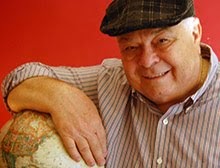 |
| Josef Stalin called the metro stations of Moscow "People's Palaces" (Photo: Jorge Láscar -- licensed under the Creative Commons Attribution 2.0 Generic license) |
Josef
Stalin called the stations “people’s palaces” because of their elaborate
artistic and architectural designs. They
also were the largest civilian construction project in the history of the USSR
By using
a mostly volunteer workforce at a time when capitalism was suffering through
the Depression, Stalin aimed to impress the world with his country’s
technology, industrialization and art, demonstrating the superiority of
socialism.
 |
| Early stations were the most eclectic (Photo: licensed under the Creative Commons Attribution-Share Alike 4.0 International license) |
With
elegant chandeliers, friezes, marble archways, bronze statues, stained glass
windows and bas-reliefs, each metro station in Moscow
The
earliest stations are perhaps the most ornate and eclectic because of the
intensity with which Stalin sought completion. Among the artistic depictions,
as would be expected, are representations with particularly Soviet cultural
themes such as sports, industry, agriculture, history and, of course, the Revolution.
In 1935,
when the Moscow
 |
Novoslobodskaya is a cultural gem honoring Russia's military
|
One of
the earliest stations is Kievskaya
which opened in 1937. The ultra-lavish mosaic in the central hall celebrates
the 300-year-old union between Ukraine
and Russia
Another
of Stalin’s “originals”, Kurskaya,
dating to 1938, emphasizes mosaics that highlight the strength and fortitude of
Soviet society.
 |
| Mayakovskaya is one of most beautiful stations in the system (Photo: Ludvig14-- licensed under the Creative Commons Attribution-Share Alike 4.0 International license) |
Among
the most beautiful, and perhaps the most famous, Mayakovskaya,
opened in 1938. Dedicated to the Russian poet Vladimir Maykovsky, it is one of
the deepest stations in the city because it was also designed for use as a bomb
shelter.
Believe
it or not, another metro system, called Metro 2, was created beneath the being
used today as an escape route for high government officials.
 |
| One station was designed as a bomb shelter (Photo: Mos.ru -- licensed under the Creative Commons Attribution-Share
Alike
4.0 International license)
|
With
seven hexagonal mosaic panels by the famed Russian artist Frolov, Novokuznetskaya is cultural gem though it did not open
until 1943. The ceilings are dedicated to Soviet military operations and
industry.
Don’t be
misled, not all of Moscow
Khruschev’s
spartan influence only lasted about 20 years. Since the mid-1970s the elaborate
architecture of the metro has returned with more contemporary designs, although
not to the degree or depth they were under Stalin.
 |
| Komsomolskaya Station is a favorite (Photo: www.all-free-photos.com) |
Komsomolskaya is one of the most popular stations
constructed during the Khruschev era. It is a favorite because of its Baroque
style and arched yellow ceiling.
Another
station under Khruschev’s leadership is Vorobyovy Gory. Built in 1959, it rates a mention because
it is the first metro station ever constructed on a bridge.
 |
| Dostoevskava Station dedicated to author Fyodor Dostoyvsky (Photo: @Alex 'Florstein' Fedorov-- licensed under the Creative Commons Attribution-Share Alike 4.0 International license) |
Rounding
out the list, one of the most popular stations only came into existence in
2003. In a city where the metro stations are known for their depth, Park Pobedy
is the deepest. At 414 feet, the escalators are the longest in Europe , taking about three minutes to arrive at the
street. Or, for the hardy, you can climb the 740 steps to the surface.
Two huge
panels decorate the walls of Park Pobedy with enameled depictions of the War of
1812 in the north hall and another highlighting the victory over Nazism in the
south hall.
TIPS:
The
system is color coded, but it is useful to have a map written in Russian so you
can visually match the station stops.
Be alert
for pickpockets, especially during peak hours when the metros are busiest. The
best time to ride without crowds is between noon and 2 pm.
Though
many stations are magnificent, the rolling stock can be quite old, so do not
expect stations to be quiet.


































